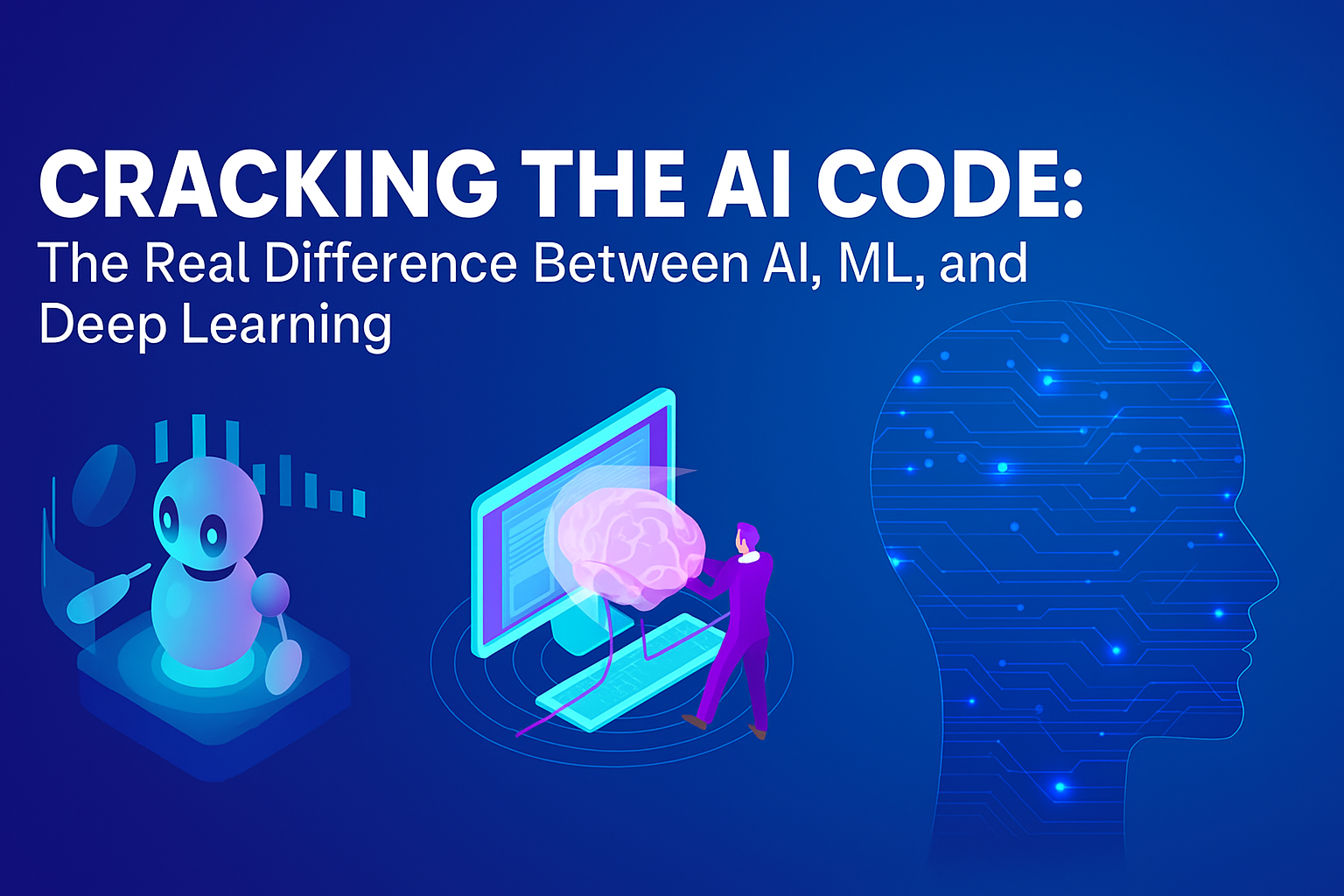Introduction
Ever wondered how Netflix knows what you want to watch before you do? Or how your phone magically unlocks just by looking at your face? Welcome to the world powered by AI, ML, and Deep Learning.
These buzzwords are thrown around like confetti in the tech world, but what do they actually mean? Are they the same thing dressed in different clothes—or are there real differences under the hood?
Let’s dive deep and demystify the layers of this intelligent tech trifecta.
What is Artificial Intelligence (AI)?
A Simple Definition
Artificial Intelligence, or AI, is the broadest term of the trio. It’s essentially about making machines think, act, and make decisions like humans—well, at least try to.
Think of AI as the master umbrella under which all intelligent systems live, from voice assistants to self-driving cars.
Types of AI
Narrow AI
Also called “Weak AI,” this type is trained for specific tasks only—like Alexa playing your favorite song or a spam filter in your email.
General AI
Now we’re talking Hollywood stuff. General AI would perform any intellectual task a human can. We’re not quite there yet.
Superintelligent AI
This is theoretical AI that would surpass human intelligence. Think Terminator or Jarvis from Iron Man. Fascinating, but slightly terrifying.
Everyday Examples of AI
- Siri and Google Assistant
- Smart home automation
- Customer service chatbots
- Fraud detection systems in banks
What is Machine Learning (ML)?
Definition of Machine Learning
Machine Learning is a subset of AI that allows systems to learn from data and improve without being explicitly programmed every step of the way.
Imagine teaching your dog new tricks, but instead of treats, you use tons of data.
How ML Works: Training, Testing, Predicting
- Training – Feeding data to the machine.
- Testing – Checking how well it learned.
- Predicting – Using the learning to make future decisions.
Types of Machine Learning
Supervised Learning
You train the model with labeled data. Think of it as solving a puzzle with the box cover in front of you.
Unsupervised Learning
No labels. The machine finds patterns on its own. Like exploring a new city without a map.
Reinforcement Learning
The machine learns via rewards and penalties—very much like training pets!
Real-World Applications of ML
- Product recommendations (Amazon)
- Email spam detection
- Predictive maintenance in manufacturing
- Stock market forecasting
What is Deep Learning (DL)?
Understanding Deep Learning
Deep Learning is a subset of Machine Learning that uses complex algorithms inspired by the structure of the human brain—called artificial neural networks.
It’s ML taken to the next level with layers and layers of decision-making.
The Role of Neural Networks
Neural networks mimic how humans process information, with layers that analyze inputs, extract features, and make decisions. It’s like a brain made of code.
Deep Learning vs Machine Learning
| Criteria | Machine Learning | Deep Learning |
|---|---|---|
| Feature Engineering | Manual | Automatic |
| Data Requirements | Moderate | Massive |
| Hardware Needs | Low to Medium | High (GPUs/TPUs) |
| Accuracy | Good | Very High |
Real-World Use Cases of Deep Learning
- Self-driving cars
- Facial recognition
- Natural language translation
- Voice synthesis (like Alexa or Siri)
Key Differences Between AI, ML, and DL
The Hierarchical Relationship
- AI is the big picture
- ML is a way to achieve AI
- DL is a technique within ML
Like Russian dolls—DL fits into ML, which fits into AI.
Data Dependency
- AI can function with less data.
- ML needs more.
- DL? It needs tons of it.
Accuracy and Performance
- DL offers the most precision, especially with unstructured data like images and sound.
Hardware Requirements
- DL usually needs powerful GPUs.
- ML is more flexible and lightweight.
Human Intervention
- ML still requires human guidance in feature extraction.
- DL does that all by itself.
Visualizing the Difference: The AI Pyramid
plaintextCopyEdit Artificial Intelligence (AI)
/ \
Machine Learning (Rule-Based Systems)
/
Deep Learning (Neural Networks)
A helpful image to burn into your brain 🧠.
When to Use AI, ML, or Deep Learning in Business
- Use AI: When you need intelligent automation across multiple departments (e.g., enterprise resource planning).
- Use ML: When your business has data that can be used to predict behavior (e.g., customer churn).
- Use DL: When you’re handling massive unstructured data (e.g., image recognition in healthcare diagnostics).
Challenges in Adopting AI, ML, and DL
- Data Privacy Concerns
- High Costs of Implementation
- Shortage of Skilled Professionals
- Algorithmic Bias
- Explainability (especially in DL)
The Future of AI, ML, and Deep Learning
AI is no longer futuristic—it’s now. But we’re still just scratching the surface. As models evolve, we’ll see more autonomous systems, smarter assistants, and AI augmenting rather than replacing humans.
From emotional AI to generative systems, the future looks complex—but insanely exciting.
Conclusion
AI, ML, and Deep Learning are not interchangeable—they’re layers of intelligence, each with its own purpose, tools, and limitations.
Understanding their differences isn’t just for tech nerds. If you’re a business owner, a curious learner, or someone wondering if robots are coming for your job—it pays to know what’s what.
So next time someone throws these terms around, you’ll be the smartest person in the room. 😉
FAQs
1. What’s the simplest way to remember the difference between AI, ML, and DL?
Think of AI as the goal, ML as the path, and DL as the high-performance vehicle on that path.
2. Can we have Deep Learning without Machine Learning?
Nope. DL is a part of ML. No ML, no DL.
3. Is AI dangerous?
It depends. AI isn’t inherently dangerous, but how we use it matters a lot. Responsible AI development is key.
4. What are some top industries using these technologies?
Healthcare, finance, retail, logistics, education, and cybersecurity—to name just a few.
5. Do I need coding knowledge to learn AI or ML?
While coding helps a lot (especially Python), there are many beginner-friendly platforms that require little to no code.







